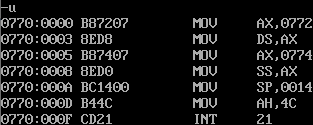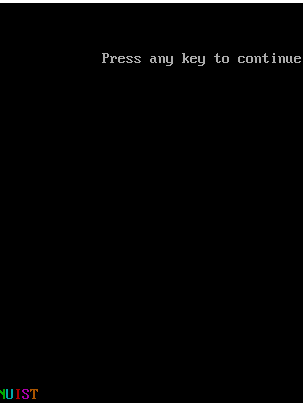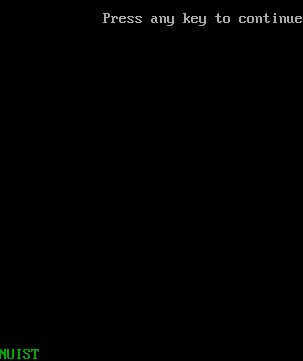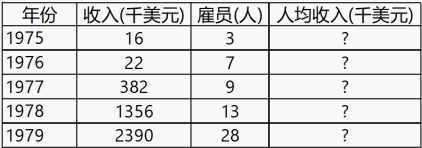Experimental task 1
This experimental task includes 4 sub tasks. Practice one by one, observe and verify in combination with practice, and answer questions.
Task 1-1
Click to view task1_1.asmassume ds:data, cs:code, ss:stack
data segment
db 16 dup(0)
data ends
stack segment
db 16 dup(0)
stack ends
code segment
start:
mov ax, data
mov ds, ax
mov ax, stack
mov ss, ax
mov sp, 16
mov ah, 4ch
int 21h
code ends
end start
- Question one
In debug, it will be executed until the end of line17 and before line19. At this time, record that the register (DS) is__ 770__, Register (SS) yes__ 771__ Register (CS) is__ 772__. - Question two
Assuming that the segment address of the code segment is X after the program is loaded, the segment address of the data segment is X__ X-2__ The segment address of stack is__ X-1__.
Task 1-2
Click to view task1_2.asmassume ds:data, cs:code, ss:stack
data segment
db 4 dup(0)
data ends
stack segment
db 8 dup(0)
stack ends
code segment
start:
mov ax, data
mov ds, ax
mov ax, stack
mov ss, ax
mov sp, 8
mov ah, 4ch
int 21h
code ends
end start
- Question one
In debug, it will be executed until the end of line17 and before line19. At this time, record that the register (DS) is__ 770__, Register (SS) yes__ 771__ Register (CS) is__ 772__. - Question two
Assuming that the segment address of the code segment is X after the program is loaded, the segment address of the data segment is X__ X-2__ The segment address of stack is__ X-1__.
Task 1-3
Click to view task1_3.asmassume ds:data, cs:code, ss:stack
data segment
db 20 dup(0)
data ends
stack segment
db 20 dup(0)
stack ends
code segment
start:
mov ax, data
mov ds, ax
mov ax, stack
mov ss, ax
mov sp, 20
mov ah, 4ch
int 21h
code ends
end start
- Question one
In debug, it will be executed until the end of line17 and before line19. At this time, record that the register (DS) is__ 770__, Register (SS) yes__ 772__ Register (CS) is__ 774__. - Question two
Assuming that the segment address of the code segment is X after the program is loaded, the segment address of the data segment is X__ X-4__ The segment address of stack is__ X-2__.
Tasks 1-4
Click to view task1_4.asmassume ds:data, cs:code, ss:stack
code segment
start:
mov ax, data
mov ds, ax
mov ax, stack
mov ss, ax
mov sp, 20
mov ah, 4ch
int 21h
code ends
data segment
db 20 dup(0)
data ends
stack segment
db 20 dup(0)
stack ends
end start
- Question one
In debug, it will be executed until the end of line17 and before line19. At this time, record that the register (DS) is__ 772__, Register (SS) yes__ 774__ Register (CS) is__ 770__. - Question two
Assuming that the segment address of the code segment is X after the program is loaded, the segment address of the data segment is X__ X+2__ The segment address of stack is__ X+4__.
Tasks 1-5
Based on the practice and observation of the above four experimental tasks, summarize and answer:
-
Question one
For the segment defined below, after the program is loaded, the actual memory space allocated to the segment is _.xxx segment db N dup(0) xxx ends
The actual space is 16*Math.ceil(N/16) bytes
-
Question two
If the program Task1_ 1.asm, task1_ 2.asm, task1_ 3.asm, task1_ 4. In ASM, if the pseudo instruction end start is changed to end, which program can still be executed correctly? The reasons are analyzed and explained in combination with the conclusions obtained from practical observation.- task1_1.asm

- task1_2.asm

- task1_3.asm

- task1_4.asm

Conclusion: end start indicates that the program entry is at start. If not, it will be executed from the first line of the program. The first three programs directly execute the space declaration, so the program cannot be recognized, while the last one executes the correct code first and then declares the space, so the program can be recognized correctly, that is, the execution sequence of the fourth program has not changed due to the lack of start.
- task1_1.asm
Experimental task 2
Write an assembly source program to realize 160 consecutive bytes to memory units b800:0f00 ~ b800:0f9f, and fill hexadecimal data 03 and 04 repeatedly in turn.
requirement
1 in task 3 of Experiment 1, experiments with the same effect were done. But at that time, the filling was realized through the f command of debug. This time, programming is required.
2. When programming, pay attention to the problems of hexadecimal and byte order. After writing, run the program. If the result is inconsistent with that of experiment task 3 of Experiment 1, it indicates that the program is wrong.
The code is as follows:
Click to view the codeDATAS SEGMENT
;Enter segment code here
DATAS ENDS
STACKS SEGMENT
;Enter the stack segment code here
STACKS ENDS
CODES SEGMENT
ASSUME CS:CODES,DS:DATAS,SS:STACKS
START:
mov ax,0b800h
mov ds,ax
mov bx,0f00h
mov cx,80
s:mov byte ptr ds:[bx],0003h
inc bx
mov word ptr ds:[bx],0004h
inc bx
loop s
mov ah, 4ch
int 21h
CODES ENDS
END START
Experimental results:

It can be found that the modification was successful. However, some contents belonging to read-only memory cannot be changed.
Experimental task 3
It is known that the 8086 assembly source program task3.asm code fragment is as follows.
Click to view task3.asmassume cs:code
data1 segment
db 50, 48, 50, 50, 0, 48, 49, 0, 48, 49 ; ten numbers
data1 ends
data2 segment
db 0, 0, 0, 0, 47, 0, 0, 47, 0, 0 ; ten numbers
data2 ends
data3 segment
db 16 dup(0)
data3 ends
code segment
start:
; ×××
code ends
end start
requirement
1 programming adds the data of logical segment data1 and logical segment data2 in turn, and the results are saved in logical segment data3.
2 load, disassemble and debug in debug. Before and after the data items are added in turn, check the memory space corresponding to the three logical segments data1, data2 and data3 respectively. After adding them one by one, ensure that the results exist in the logical segment data3.
assume cs:code
data1 segment
db 50, 48, 50, 50, 0, 48, 49, 0, 48, 49 ; ten numbers
data1 ends
data2 segment
db 0, 0, 0, 0, 47, 0, 0, 47, 0, 0 ; ten numbers
data2 ends
data3 segment
db 16 dup(0)
data3 ends
code segment
start:
mov ax,data1
mov ds,ax
mov ax,data2
mov es,ax
mov ax,data3
mov ss,ax
mov bx,0
mov cx,10
s:mov ax,0
add ax,ds:[bx]
add ax,es:[bx]
mov ss:[bx],ax
inc bx
loop s
mov ah, 4ch
int 21h
code ends
end start
Segment 1:

Segment 2:

Segment 3:

You can clearly see that the results are correct and saved in data3.
Experimental task 4
It is known that the 8086 assembly source program task4.asm code fragment is as follows
Click to view task4.asmassume cs:code
data1 segment
dw 2, 0, 4, 9, 2, 0, 1, 9
data1 ends
data2 segment
dw 8 dup(?)
data2 ends
code segment
start:
; ×××
mov ah, 4ch
int 21h
code ends
end start
requirement
1 complement program to store the 8-word data in logical segment data1 in reverse order in logical segment b.
2. After assembly and connection, load the program in debug, run to line15, and before the program exits, use the d command to check the memory space corresponding to data segment data2 to confirm whether the subject requirements are met.
assume cs:code
data1 segment
dw 2, 0, 4, 9, 2, 0, 1, 9
data1 ends
data2 segment
dw 8 dup(?)
data2 ends
code segment
start:
mov ax,data1
mov ds,ax
mov ax,data2
mov es,ax
mov bx,0
mov si,14
s:mov ax,ds:[bx]
mov es:[si],ax
add bx,2
sub si,2
loop s
mov ah, 4ch
int 21h
code ends
end start
result:

It is clear that they have successfully discharged in reverse order.
Experimental task 5
Use any text editor to enter the assembly source program task5.asm.
Click to view task5.asmassume cs:code, ds:data
data segment
db 'Nuist'
db 2, 3, 4, 5, 6
data ends
code segment
start:
mov ax, data
mov ds, ax
mov ax, 0b800H
mov es, ax
mov cx, 5
mov si, 0
mov di, 0f00h
s: mov al, [si]
and al, 0dfh
mov es:[di], al
mov al, [5+si]
mov es:[di+1], al
inc si
add di, 2
loop s
mov ah, 4ch
int 21h
code ends
end start
Experimental steps:
- Assemble and link the program to get the executable file, run and observe the results.
- Use the debug tool to debug the program and observe the results before the program returns, that is, after line25 and before line27.
- What is the function of line19 in the source code?
- Modify the value of 5 byte units in line4, reassemble, link, run and observe the results.
Based on observation, analyze and guess what the numerical function here is.db 2,3,4,5,6 --> Change to: db 5 dup(2) or db 5 dup(5)
answer:
-

-

-
Convert lowercase letters into uppercase letters in data
-

The values here are used to adjust the color of each character.
Experimental task 6
It is known that the 8086 assembly source program task6.asm code fragment is as follows.
Click to view task6.asmassume cs:code, ds:data
data segment
db 'Pink Floyd ' ; 16 byte
db 'JOAN Baez ' ; 16 byte
db 'NEIL Young ' ; 16 byte
db 'Joan Lennon ' ; 16 byte
data ends
code segment
start:
; xxx
mov ah, 4ch
int 21h
code ends
end start
requirement
1 complete the program and change the first word of each line in the data section from uppercase to lowercase.
2 load the program in debug, disassemble it, and check the memory space corresponding to the data section with the d command before line13 exits, and confirm that the first word in each line has changed from uppercase to lowercase.
assume cs:code, ds:data
data segment
db 'Pink Floyd ' ; 16 byte
db 'JOAN Baez ' ; 16 byte
db 'NEIL Young ' ; 16 byte
db 'Joan Lennon ' ; 16 byte
data ends
code segment
start:
mov ax,data
mov ds,ax
mov bx,0
mov cx,4
mov si,0
s:mov al,ds:[0+si]
or al,20H
mov ds:[0+si],al
add si,16
loop s
mov ah, 4ch
int 21h
code ends
end start
result:
The first line originally:
After the first line is changed:
The second line originally:
After the second line is changed:
The third line originally:
After the third line is changed:
The fourth line was originally:
After the fourth line is changed:
You can clearly see that the required functions are implemented.
Experimental task 7
Problem scenario description:
The basic information of Power idea from 1975 to 1979 is as follows:

These data have been defined in the logical segment data (line4-6) of program task7.asm.
assume cs:code, ds:data, es:table
data segment
db '1975', '1976', '1977', '1978', '1979'
dw 16, 22, 382, 1356, 2390
dw 3, 7, 9, 13, 28
data ends
table segment
db 5 dup( 16 dup(' ') ) ;
table ends
code segment
start:
mov ah, 4ch
int 21h
code ends
end start
Data format requirements for final display:

At the same time, the per capita income can be kept as an integer
assume cs:code, ds:data, es:table
data segment
db '1975', '1976', '1977', '1978', '1979'
dw 16, 22, 382, 1356, 2390
dw 3, 7, 9, 13, 28
data ends
table segment
db 5 dup( 16 dup(' ') )
table ends
code segment
start:
mov ax,data
mov ds,ax
mov ax,table
mov es,ax
;mov ax,ds:[1]
;bx,si,di
mov cx,5
mov bx,0
mov si,0
s1:mov ax,ds:[bx]
mov es:[si],ax
add bx,2
mov ax,ds:[bx]
add si,2
mov es:[si],ax
add bx,2
add si,14
loop s1
mov bx,20
mov cx,5
mov si,5
s2:mov ax,ds:[bx]
mov es:[si],ax
add si,2
mov word ptr es:[si],0
add bx,2
add si,14
loop s2
mov bx,30
mov cx,5
mov si,10
s3:mov ax,ds:[bx]
mov es:[si],ax
add bx,2
add si,16
loop s3
mov bx,20
mov di,30
mov cx,5
mov si,13
s4:mov ax,ds:[bx]
mov dl,ds:[di]
div dl
mov es:[si],al
add bx,2
add di,2
add si,16
loop s4
mov ah, 4ch
int 21h
code ends
end start
result:

Inspection:
- The data structure meets the requirements.
- The year, income and employee are copied, but the income is two bytes more. It is confirmed that the data is correct.
- Per capita income: (decimal) 16 / 3 = 5,22 / 7 = 3382 / 9 = 421356 / 13 = 1042390 / 28 = 85
Converted to hexadecimal: 05,03,2A,68,55 -- the data is confirmed to be correct.
summary
- Have a deeper understanding of the knowledge of data segment definition, be able to flexibly use multiple data segments, and master the relevant knowledge of the size limit of data segments and the relationship between data segment address and cs.
- Master the registers commonly used in operand addressing, and be able to use them to address flexibly.
- Master the pseudo instructions including db, dw, dd, dup and ptr. At the same time, it can also flexibly use ordinary instructions such as addition, subtraction, multiplication and division and and and or, and can complete simple work.
- More flexible use of debugging commands to debug programs.
- Learned some markdown syntax to make the page more hierarchical and focused.